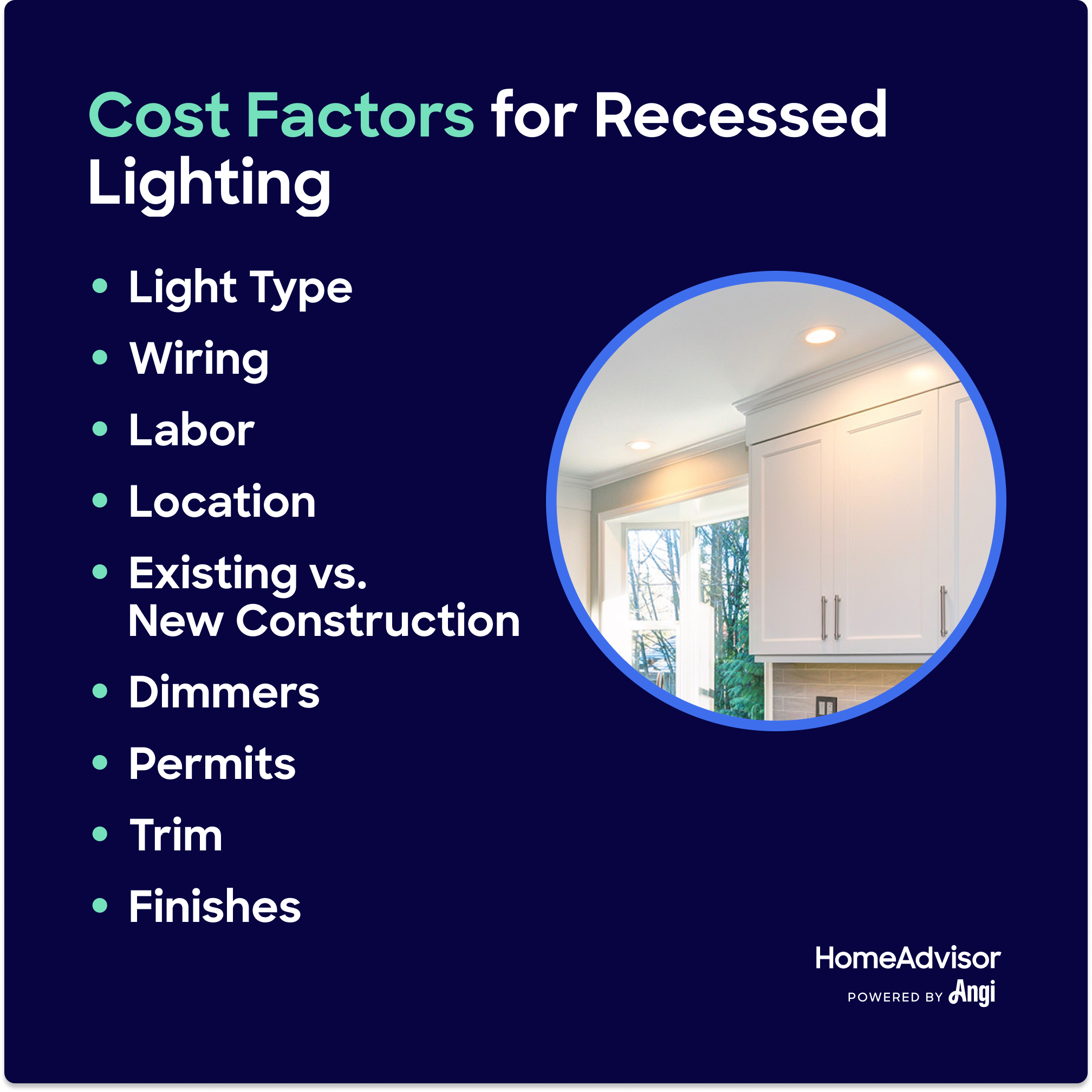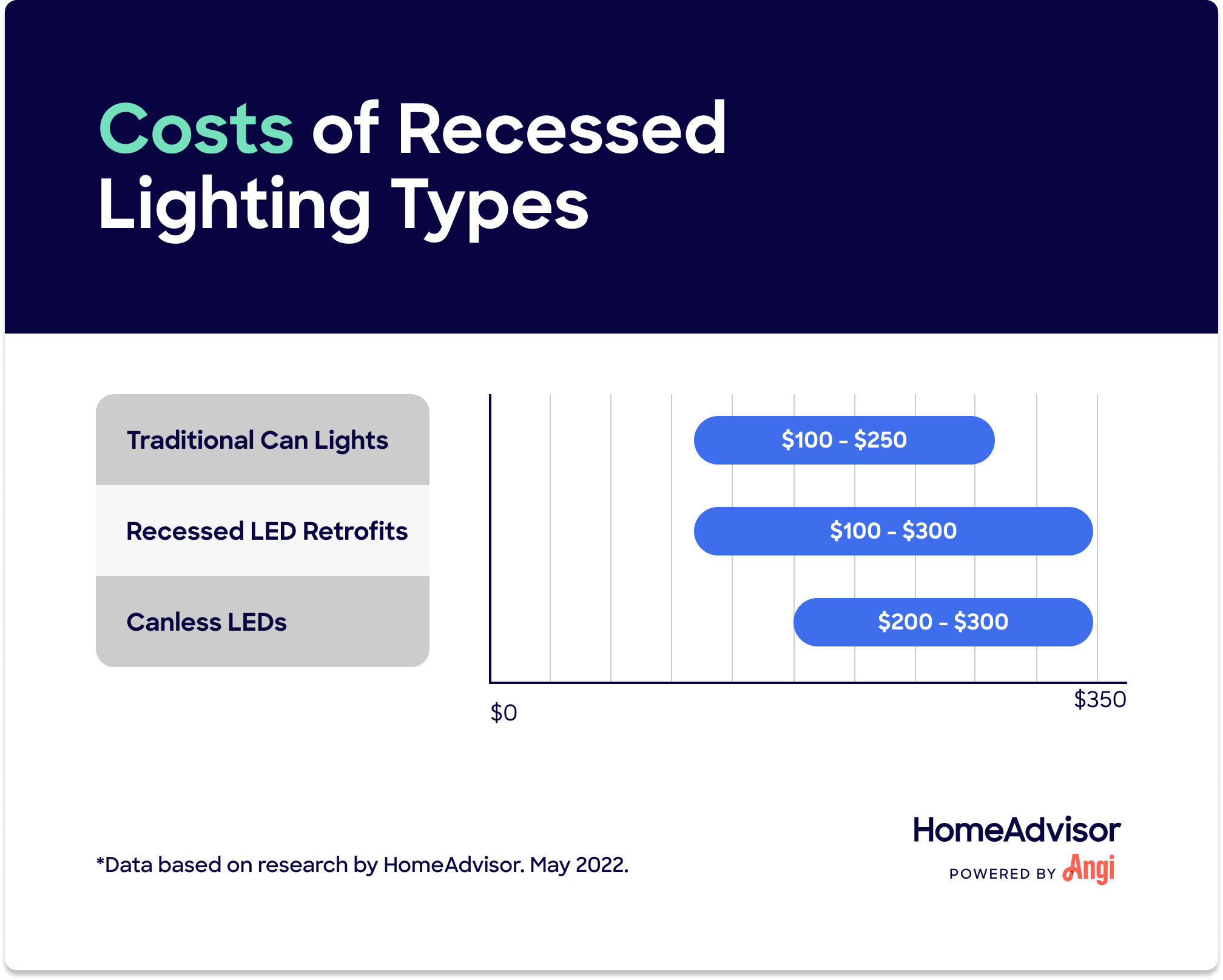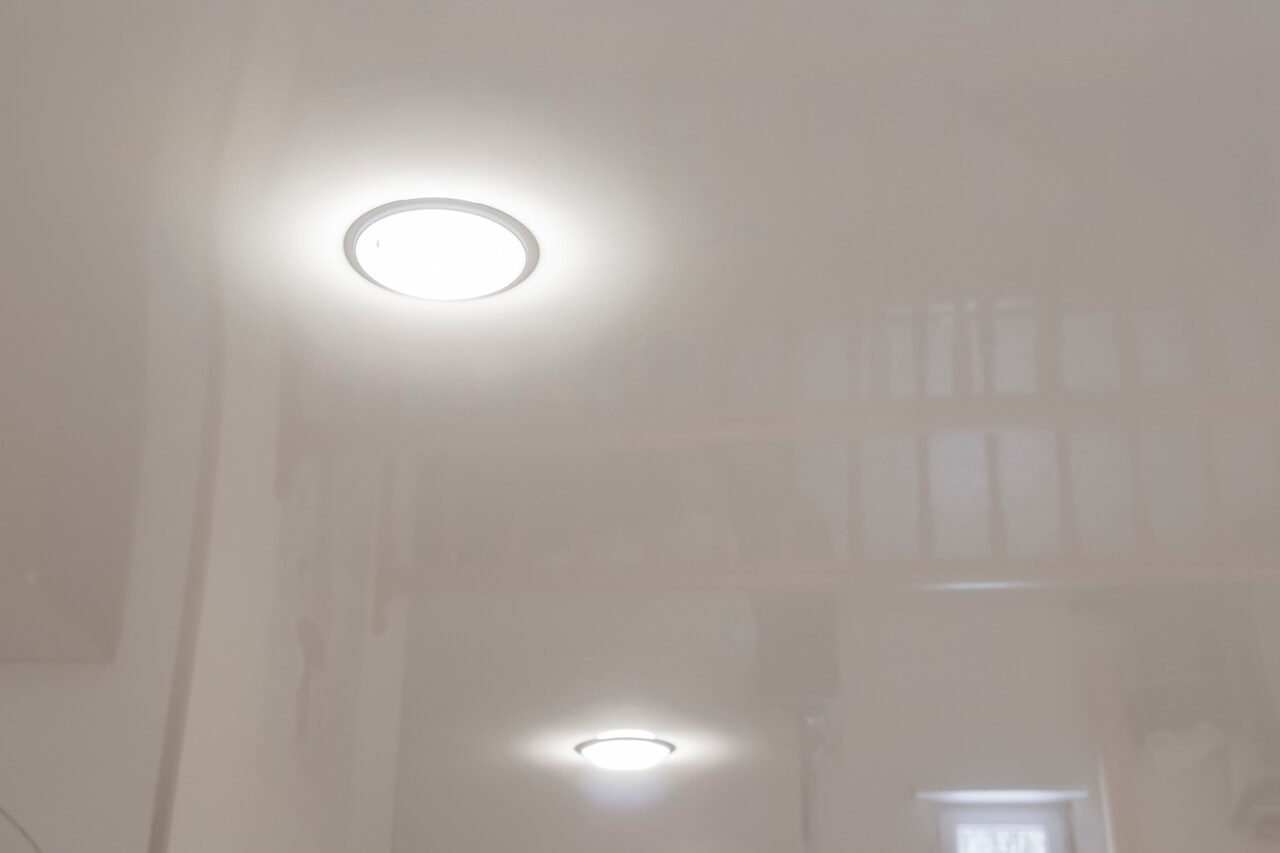How Much Does Recessed Lighting Cost?
Typical Range:
$100 - $500
Typical Range:
$100 - $500
Cost data is based on research by HomeAdvisor.
Updated June 6, 2022
Reviewed by Salvatore Cutrona, Angi Expert Review Board member and founder of Cutrona Electric, LLC, in Sherman, CTOn average, recessed lighting costs around $300 per light fixture, including materials and installation. Depending on the light housing, trim, and finish, your total cost of installing recessed lighting will fluctuate between $100 to $500 per light fixture.
Most homeowners will install anywhere from four to six recessed lighting fixtures per project, which can reach $1,700, though most projects will fall within $400 to $3,000.
| Minimum Cost | Average Cost | Maximum Cost |
|---|---|---|
| $100 | $300 | $500 |
Recessed lighting has some of the widest range of customizations. When paired with supplies and labor fees, your overall project price will fluctuate.
There are three main types of recessed lighting, including canless LEDs, recessed LED retrofits, and traditional can lights. Traditional can lights are often used to replace older can fixtures. Because you only need to buy the fixtures, as the wiring is already in place, you may find that traditional canned recessed lighting projects come in at a lower installation cost.
Canless LEDs and recessed LED retrofits, on the other hand, are used in new constructions or recessed lighting remodels.
From a design perspective, recessed lighting fixtures are mounted in the ceiling rather than hung as a chandelier would. For this reason, a professional electrician near you will need to access the attic or the second floor to complete this job properly.
Running wire through the attic is simpler than on a second floor because there’s no flooring getting in the way. It’s a relatively open area with a lot of room to work with the wiring. Prepare for a significant increase in labor costs if you’re installing wire on the ground floor of a two-story home.
The cost to install electrical wiring will fall between $0.20 to $2 per linear foot.
The cost to hire an electrician will run you around $85 to $105 per hour, with each fixture taking around 2 1/2 hours to complete for existing construction. If you’re installing recessed lighting all on the same circuit, you’ll save a significant amount of time. Installing recessed lighting in multiple parts of the home will incur much higher labor fees due to the time it takes to run wiring to different parts of the home.
As with any home upgrade, you should budget for obstacles and setbacks if you’re installing new recessed lights in an existing home. Items such as joists, heating ducts, or other wiring may increase installation costs by upwards of $200 or more per light.
An existing home will contain air ducts, drywall, and existing wires. Working around these items typically leads to increased labor, and material costs will rise as more wiring is needed to work around the obstacles.
You’ll benefit from open walls with minimal wiring obstacles in a new construction home. This usually makes installation easier compared to an existing home—you’re likely to save upwards of five hours of work installing recessed lighting in new construction homes. With these added savings, you may consider splurging on different trims or finishes if your budget allows.
Dimmable lights are excellent ways to create the perfect ambiance in your home, depending on what you’re doing or feeling that day. If you need a dimmer switch installed with the recessed lighting, you’ll need to tack on an extra $125 to the final project cost.
If you plan to install new recessed lighting, a permit is necessary because it involves altering the house wiring. This does come down to local code ordinances, so you’ll need to ring up your local building inspection office to confirm the process and costs. The cost to obtain a building permit for electrical projects ranges from $50 to $500, depending on the city and project.
The trim is the most eyecatching aspect of recessed lighting, as it's the part you can see. Trims extend beyond the light's edge to cover the hole’s edge and seamlessly blend in with the ceiling. Available in various patterns and finishes, the right trim can add an extra layer of decor.
| Trim Type | Cost Per Piece |
|---|---|
| Baffle | $5 – $80 |
| Open | $5 – $80 |
| Slot | $10 – $50 |
| Shower | $10 – $50 |
| Reflector | $10 – $60 |
| Surface-Adjustable | $10 – $60 |
| Wall wash | $10 – $100 |
| Eyeball | $15 – $30 |
| Pinhole | $15 – $80 |
| Gimball | $15 – $90 |
| Lensed | $15 – $150 |
| Decorative | $15 – $150 |
Once you’ve selected your trim, you can further customize your recessed lighting by choosing a finish. The standard color for recessed lighting finishes is white, as it blends well with ceilings, but copper or bronze can add a rustic complement to your home’s aesthetic. Or, add subtle touches of black or gold for a moody vibe.
| Finish Type | Cost Per Piece |
|---|---|
| White | $10 – $25 |
| Gold | $10 – $45 |
| Chrome | $15 – $90 |
| Nickel | $15 – $80 |
| Copper | $25 – $60 |
| Black | $25 – $80 |
| Bronze | $30 – $60 |
Choosing between the three types of recessed lighting comes down to your individual home. New construction homes today usually install canless recessed integrated LED lights, while existing homes will have the option of replacing existing can lights with updated versions or retrofitting recessed LEDs into the existing hole.
Each type comes in a variety of styles and sizes, including 4-, 5-, and 6-inch diameters. You’ll also need to consider whether you need a high-hat fixture for any of these. High-hat fixtures protect the recessed lighting from objects falling on it and causing an electrical fire in the attic. You’ll have the option of insulation contact (IC) high-hats or non-insulation contact (non-IC), depending on whether you need to prevent heat transfer from the light.
Only choose a non-IC light if you do not have insulation in your ceiling and you do not plan to add any in the future. Otherwise, an IC-Rated can is best. Know that recessed light cans get hot, and some insulations are prone to melting or warping when they get warm.
Canless LED lights cost about $20 to $50 per fixture, or $200 to $300 per fixture including installation and wiring. New canless LED lights are equipped with highly desirable features such as LED lights that produce less heat than traditional incandescent and options for smart home lights. With smart home lights, you can dim the light, change colors, or turn them on and off remotely.
Recessed LED retrofits run the same as a canless LED light, about $20 to $50 per fixture. With labor and materials, expect to pay around $100 to $300 per light fixture.
These lights fit directly into older traditional can light spaces, which usually means you can save on labor and material costs by using the existing wiring.
For the fixture itself, budget roughly $20 to $30 per light for traditional can lights. The cost to install traditional can lights is around $100 to $250 per fixture, depending on materials and finishes. Traditional can lights are harder to find as manufacturers continue to phase out these lights for higher efficiency models. If you have traditional cans, your only option is to replace your existing bulbs.
Recessed lights are fixtures that mount to the ceiling to sit flush with their surface. They illuminate the area directly below them without spreading outward much. For that reason, these fixtures work best in low ceilings or rooms with minimalist designs.
Recessed lights are most effective when arranged every four to six feet in a room. They are compatible with dimmer switch installs to create mood lighting where you need it.
Can lights are the original traditional recessed lighting option first used in homes. However, they are no longer installed in new homes because they use incandescent lights. Modern recessed lights are LEDs and are the new standard.
Your lighting needs depend on the size of light you have and what you’re using it for. For the best lighting, install at least six pot lights for every 250 square feet. Install each light every four to six feet at max, though one every two feet is better. When designing your interior lighting, make sure the housings sit about two feet from the perimeter walls.
The average cost to install light fixtures is around $550. This cost is subjective to the type of light you’re installing, as this single light may produce just as much light as six recessed lights or may produce less light than a single recessed light.
Yes, you can have recessed lights even if you have insulated ceilings. You’ll need to use a high-hat insulated contact enclosure to ensure the heat does not create a fire hazard.
As with anything electrical, we don’t recommend DIY installs unless you’re licensed or have a tremendous amount of experience. Because of permits and building codes, you may incur fines if not installed correctly.
There’s no direct amount of ROI for installing recessed lighting, but updated lighting fixtures and the stylish nature of recessed lighting generally increase your home’s value in the eyes of a buyer.
Newer recessed LED lights use only a fraction of the wattage—around 7W to 10W on average—compared to older incandescent, fluorescent, or halogen bulbs. Older bulbs use anywhere from 25W to upwards of 75W. They also tend to produce a lot less heat, making them more energy efficient.


